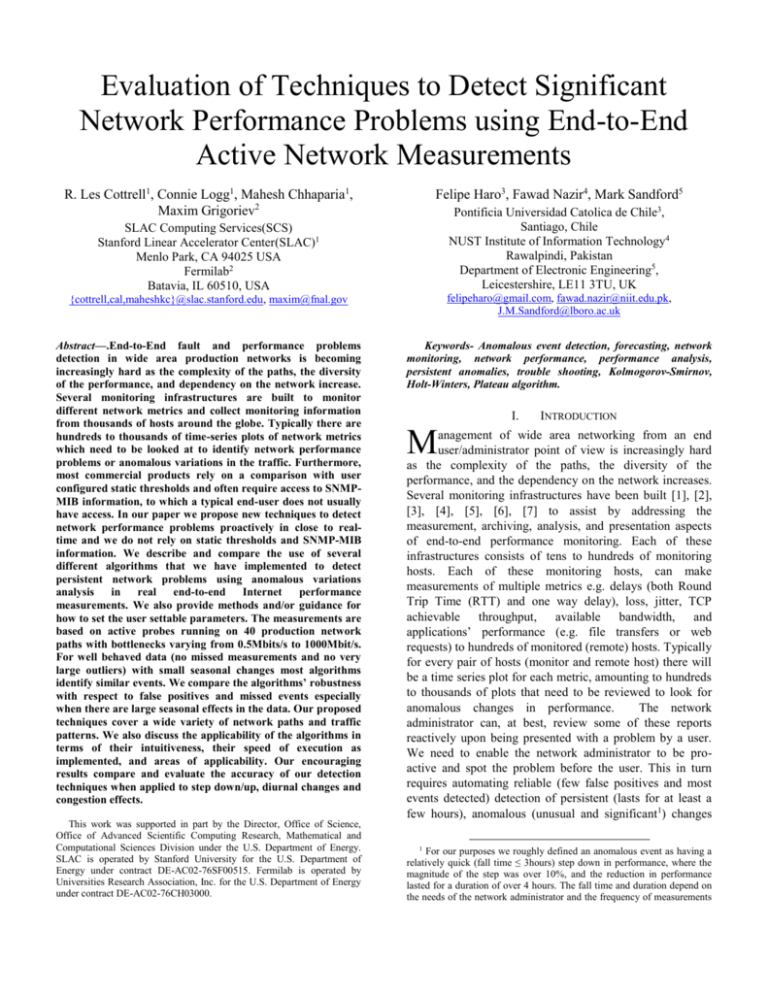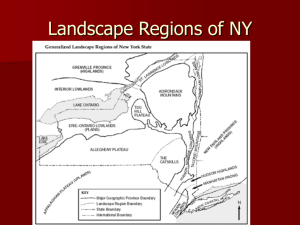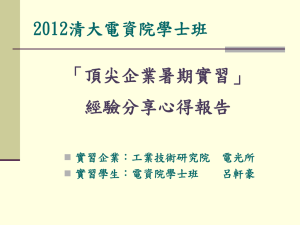Evaluation of Techniques to Detect Significant Network
advertisement

Evaluation of Techniques to Detect Significant
Network Performance Problems using End-to-End
Active Network Measurements
R. Les Cottrell1, Connie Logg1, Mahesh Chhaparia1,
Maxim Grigoriev2
Felipe Haro3, Fawad Nazir4, Mark Sandford5
Pontificia Universidad Catolica de Chile3,
Santiago, Chile
NUST Institute of Information Technology4
Rawalpindi, Pakistan
Department of Electronic Engineering5,
Leicestershire, LE11 3TU, UK
SLAC Computing Services(SCS)
Stanford Linear Accelerator Center(SLAC)1
Menlo Park, CA 94025 USA
Fermilab2
Batavia, IL 60510, USA
{cottrell,cal,maheshkc}@slac.stanford.edu, maxim@fnal.gov
felipeharo@gmail.com, fawad.nazir@niit.edu.pk,
J.M.Sandford@lboro.ac.uk
Abstract—.End-to-End fault and performance problems
detection in wide area production networks is becoming
increasingly hard as the complexity of the paths, the diversity
of the performance, and dependency on the network increase.
Several monitoring infrastructures are built to monitor
different network metrics and collect monitoring information
from thousands of hosts around the globe. Typically there are
hundreds to thousands of time-series plots of network metrics
which need to be looked at to identify network performance
problems or anomalous variations in the traffic. Furthermore,
most commercial products rely on a comparison with user
configured static thresholds and often require access to SNMPMIB information, to which a typical end-user does not usually
have access. In our paper we propose new techniques to detect
network performance problems proactively in close to realtime and we do not rely on static thresholds and SNMP-MIB
information. We describe and compare the use of several
different algorithms that we have implemented to detect
persistent network problems using anomalous variations
analysis
in real
end-to-end Internet
performance
measurements. We also provide methods and/or guidance for
how to set the user settable parameters. The measurements are
based on active probes running on 40 production network
paths with bottlenecks varying from 0.5Mbits/s to 1000Mbit/s.
For well behaved data (no missed measurements and no very
large outliers) with small seasonal changes most algorithms
identify similar events. We compare the algorithms’ robustness
with respect to false positives and missed events especially
when there are large seasonal effects in the data. Our proposed
techniques cover a wide variety of network paths and traffic
patterns. We also discuss the applicability of the algorithms in
terms of their intuitiveness, their speed of execution as
implemented, and areas of applicability. Our encouraging
results compare and evaluate the accuracy of our detection
techniques when applied to step down/up, diurnal changes and
congestion effects.
Keywords- Anomalous event detection, forecasting, network
monitoring, network performance, performance analysis,
persistent anomalies, trouble shooting, Kolmogorov-Smirnov,
Holt-Winters, Plateau algorithm.
This work was supported in part by the Director, Office of Science,
Office of Advanced Scientific Computing Research, Mathematical and
Computational Sciences Division under the U.S. Department of Energy.
SLAC is operated by Stanford University for the U.S. Department of
Energy under contract DE-AC02-76SF00515. Fermilab is operated by
Universities Research Association, Inc. for the U.S. Department of Energy
under contract DE-AC02-76CH03000.
I.
INTRODUCTION
M
anagement of wide area networking from an end
user/administrator point of view is increasingly hard
as the complexity of the paths, the diversity of the
performance, and the dependency on the network increases.
Several monitoring infrastructures have been built [1], [2],
[3], [4], [5], [6], [7] to assist by addressing the
measurement, archiving, analysis, and presentation aspects
of end-to-end performance monitoring. Each of these
infrastructures consists of tens to hundreds of monitoring
hosts. Each of these monitoring hosts, can make
measurements of multiple metrics e.g. delays (both Round
Trip Time (RTT) and one way delay), loss, jitter, TCP
achievable throughput, available bandwidth, and
applications’ performance (e.g. file transfers or web
requests) to hundreds of monitored (remote) hosts. Typically
for every pair of hosts (monitor and remote host) there will
be a time series plot for each metric, amounting to hundreds
to thousands of plots that need to be reviewed to look for
anomalous changes in performance.
The network
administrator can, at best, review some of these reports
reactively upon being presented with a problem by a user.
We need to enable the network administrator to be proactive and spot the problem before the user. This in turn
requires automating reliable (few false positives and most
events detected) detection of persistent (lasts for at least a
few hours), anomalous (unusual and significant 1) changes
1
For our purposes we roughly defined an anomalous event as having a
relatively quick (fall time ≤ 3hours) step down in performance, where the
magnitude of the step was over 10%, and the reduction in performance
lasted for a duration of over 4 hours. The fall time and duration depend on
the needs of the network administrator and the frequency of measurements
(events) in performance and reporting them in an efficient
way to the network administrator.
Most current commercial products rely on a comparison
with a user configured static threshold value and often
require access to SNMP MIB information from network
devices that the end-user does not have permission to view.
Our intent is to dynamically derive the threshold from the
end-user accessible data so that it automatically tracks the
network’s performance.
In this paper we report on several open source approaches
to make forecasts and automatically detect persistent
anomalies in end-to-end network performance metrics using
active end-to-end network performance measurements from
an instantiation of the IEPM-BW [2] measurement
infrastructure. The requirements are to detect decreases in
performance that are sufficiently large and persist for
sufficient time that, upon notification, the local network
administrator is able to review the change and report the
problem to the up stream provider’s Network Operations
Center.
The rest of the paper is organized as follows. Section II
describes how the measurements were made, Section III
describes previous work and the parameter setting we used
for the various techniques used to extract anomalous events,
Section IV describes the results, Section V presents the
conclusions and section VI describes in progress and
possible future work.
II.
MEASUREMENTS
We use measurements from the ABwE [8] lightweight
bandwidth estimation tool that uses the packet pair
dispersion technique, and from the more intrusive [9] iperf
[10] achievable throughput estimation tool. We are also
applying the techniques to bbftp [11] and GridFTP [12]
measurements made at 60 to 120 minute intervals [13],
though the results from this are not reported here. ABwE
was chosen since it quickly (< 1 second) and with low
impact (it uses only twenty packets per direction to make a
measurement) provides both RTT and rough dynamic
bandwidth estimates, that are important to many
applications such as bulk data transfer, while it imposes a
light network load. The frequency of the measurements used
for the current work is one to three minute intervals. For
each interval, three metrics are measured: dynamic
bottleneck capacity (Cap) by analyzing the minimum packet
pair separation; Cross Traffic (Xtr) by analyzing the packet
pair dispersion; and the Available Bandwidth (Abw) = Cap –
Xtr. ABwE also simultaneously provides Cap, Xtr and Abw
measurements for the reverse direction.
The Abw measurements are probably of most interest to a
user, however they are more sensitive to cross-traffic over
which we have little control. Changes in Cap on the other
available. Less frequent measurements will necessarily increase the fall
time and duration in order to accumulate sufficient data to be statistically
meaningful.
hand are more likely to reflect route changes or operator
errors etc. and thus may be easier to address. Cap estimates
are thus generally preferred for our work. Since only 20
packet pairs are used for each bandwidth estimate, the
statistical variability of the estimates is quite high.
Estimates can thus vary dramatically from minute to minute
and have large outliers. Therefore, ABwE also provides
smoothed data using an Exponential Weighted Moving
Average (EWMA).
Single stream iperf measurements of achievable TCP
throughput were made for 15 second periods at 90 minute
intervals. Potentially the measurements can utilize a
significant fraction of the available network bandwidth for
small RTTs (less than say 20 milliseconds). At higher RTTs
the standard TCP algorithm’s congestion control recovers
slowly enough following congestion that the aggregate
utilization is not significant.
The measurements are made to about 40 hosts in 13
countries. The static bottlenecks vary from 0.5Mbits/s to
1000Mbits/s. The paths traverse about 50 Autonomous
Systems (ASs) and over 15 major Internet Service Providers
(ISPs). The topology of the remote hosts is seen in Fig. 1.
The main ISPs that the paths cross are identified as shaded
boxes. For Abilene and ESnet the major Points of Presence
(PoPs) are also identified. The remote host sites are also
noted, as well as the capacity bottlenecks (Cap) for the
paths. Five of the remote hosts (identified in Fig. 1 by “I2”
and “Host”) are at ISP PoPs, the remainder are at end user
sites.
The measurements also suffer from gaps in the
observations due to problems with the measurement host,
the paths and/or the remote (measured host).
III.
RELATED WORK AND ANALYSIS
A. Plateau Algorithm
The “Plateau” bandwidth change detection algorithm is
described in [14]. It is a modification of the algorithm
described in [15] that was successfully used to detect step
changes in a time series set of measurements of RTT. Here
we use it to analyze both the Abw and Cap measurements.
Currently, missing measurements (e.g. because there is no
functioning path between the monitor and monitoring host)
are ignored and not assumed to be zero.
The Plateau algorithm basically divides the measurements
into two buffers: a history buffer (h) for base-lining, or into
a trigger buffer (t), when a measurement meets a specific
requirement. The specific requirement is that the current
measurement is less than (we use bold face to indicate a
user settable parameters) standard deviations (oh) below the
current mean of the history buffer mh. If the measurement is
placed in h then the oldest entry is removed from t. The
buffers have maximum durations of (history) and
(trigger). Given a requested buffer duration, the number of
items in a buffer (length) is calculated using the median time
separation of the data points. When is reached the mean of
the trigger buffer mt is compared with mh and if the relative
difference = (mh – mt) / mh is greater than the threshold
then an event is deemed to have occurred.
Figure 1: Topology of the remote hosts measured from SLAC
Bandwidth from SLAC to U Florida
1000
*
800
Event
detected
mh
35
= 2;
= 0;
= 333 points (600 mins);
= 33 points(60 mins)
600
30
25
20
mh
15
400
10
200
m h - * oh
Trigger buffer length
5
0
6/19/04 0:00
Sat
Trigger buffer length
Bandwidth (Mbits/s)
EWMA(Abw)
0
6/21/04 0:00
Mon
6/23/04 0:00
Wed
6/25/04 0:00
Fri
6/27/04 0:00
Sun
Mon
Figure 2 : ABwE bandwidth estimates from SLAC to U.
Florida with a history buffer duration () of 10 hours.
Sensible values of are between 2 and 3 [16], we used =
2. minimize the effects of diurnal changes we used = 1
day. Less frequent measurements will require to be longer.
In general we believe should be aligned with any
seasonality in the data (e.g. an integral number of days) the
length of the history buffer should be > 100 points and
should be >> Larger values flatten the time series
behavior of mh, shorter values will yield less statistically
accurate values of mh. Values that are not aligned with the
seasonality (in our case the diurnal behavior) of the data will
result in the sinusoidal-wave like curve of mh being out of
synchronization with the diurnal changes (see for example Fig.
2 (where = 10 hours, = 3 hours, = 0%), and is seen to
trail the EWMA(Abw) by several hours). Note that missing
data points can also cause loss of synchronization. Since we
were only interested in long term changes we typically use =
3 hours. For measurements at 3 minute intervals this gives a
trigger buffer length of 60 that gives sufficient statistical
accuracy. We currently use = 33%. Larger values of are
likely to miss more real events; lower values are likely to lead
to more false positives.
B.
Kolmogorov-Smirnov (KS)
The KS test [17] is the best known of several distribution
free techniques that test general differences between
distributions. The technique makes no assumption about the
underlying distribution of the measurements. It compares the
observed and expected Cumulative Distribution Functions
(CDF) for M data points before (expected) and after
(observed) each measurement being evaluated. The KS
statistic is calculated taking the vertical difference between the
two CDFs as a test statistic. We define the KS parameter (K)
as the threshold value of the KS statistic above which an event
is deemed to have occurred. M in the current work was chosen
to be 100 (5 hours for measurements separated by 3 minutes)
as a reasonable compromise between the accuracy obtained
(sufficient points for the distributions) and the time to wait for
a response or the analysis time. If response time is deemed
less important it may well be worth using a larger value of M
as this will provide a larger sample for each distribution. For
previous work [18] with less frequent measurements, we chose
M to be 24 hours worth of data to minimize the diurnal effects
as discussed earlier in the current paper (although one still gets
false positives associated with weekends, public holidays etc.)
C.
Holt-Winters (HW) Algorithm
The Holt-Winters (HW) [19] [20] algorithm uses a triple
EWMA approximation to characterize the time series behavior
as a superposition of three components: a baseline, a linear
trend and a seasonal effect (e.g. diurnal changes). We
developed two implementations of the HW technique and also
used the RRD implementation [19] to compare our results
against, and to understand the technique. We will focus our
discussion on the implementation developed at SLAC (based
on the formulation in [20]) since it has the most flexibility for
our needs.
HW is critically dependent on having regularly spaced data
with no missing points, so the first step is to bin the data into
regularly spaced time bins and use similar data to interpolate
for bins with no data. For bins with no data in the first week
we use data from following weeks for the same day and time
bin. For the following weeks we use the previous week’s
interpolated data. For our data with bin widths of 3 minutes we
found that having about five to seven weeks of data enabled us
to successfully interpolate the data and fill in missing bins.
Once we have the first week’s interpolated data, new data can
be quickly merged onto the existing interpolated data without
having to go back through all the data.
Due to the noisiness of the data, we also set the maximum
forecast = maximum of all observed values.
We used the following two methods to choose the initial
HW parameters.
1. We chose the initial HW parameters using the
guidelines in [18]. 99% of the contribution for the
baseline EWMA came from measurements made
in the last 24 hours; 99% of the seasonal EWMA
contribution came from the last week, 50% of the
trend EWMA contribution came from the last 24
hours.
2. For each path, we minimized the sum of the
squares of the residuals (R2 = Σri2, where ri = yi – fi,
the sum is over all interpolated data, yi is the
interpolated observation at time i and fi is the
forecast at the same time) as a function of the HW
parameters. This method always resulted in the
trend parameter being set to very close to 0 (<
0.00001).
We have settled on using the second method. It provides
good forecasts, works for a wider range of paths and requires
minimal user input.
HW is a forecasting technique, and needs to be
complemented with a method to identify events. The
following techniques analyze HW residuals in different ways
to raise events:
The residual (ri) at each point was examined to see if it
was a trigger, i.e. outside the standard deviation of the
forecast for the last say 100 points. If 70% of the points
in a window of 2.5 hours were triggers then an event was
generated (referred to as HWR).
The residual was compared to the EWMA of the
absolute deviation [18]. If over 82% of the residuals
were outside twice the EWMA of the absolute deviation
in the last 84 minutes then an event was generated
(referred to as HWE).
With a moving window sized to cover 12 hours we
calculated Χ2 = Σri2/ fi, and using tabulated Χ2 values
for N-1 degrees of freedom, where N is number of points
per time window, we set a threshold to generate our
triggers and more than 50% of points in the time window
generated triggers then an event was raised (referred to
as HWX).
We applied the Plateau algorithm on HW residuals (PHR
technique) and KS on HW residuals (KHR technique).
D. Mark Burgess (MB) Technique
The Mark Burgess (MB) technique introduces a two
dimensional time approach [21] to classify a periodic, adaptive
threshold for service level anomaly detection. An iterative
algorithm is applied to history analysis on this periodic time to
provide a smooth roll-off in the significance of the data with
time. This method was originally designed to detect anomalous
behavior on a single host, with the aim of using the information
for self-regulation, by initiating a counter response. An
anomaly is indicated by a code indicating the state of the given
statistic, as compared to an average of equivalent earlier times.
RESULTS
Figure 3: Percentiles of capacity bandwidth (Cap) seen on
the SLAC-NIIT path as a function of time of day
One host (ANL) exhibited regular “host” type events that
were tracked down to a cron job running on the host that
used (via NFS) the network heavily. This host was eliminated
from further non-seasonal analyses. Events for a given host
typically have a small range for (standard deviation () /
mean () ~ 0.11± 0.1) indicating that the backup routes or
diurnal behavior is consistent. This manifests itself in a multimodal Distribution Function for with a small number of
modes.
Histogram of KS (>0.6) anomalous events as
a function of time of day for NIIT
40
100%
80%
60%
40%
20%
0%
CDF
Frequency
Cumulative %
30
20
0:00:00
21:00:00
18:00:00
15:00:00
12:00:00
9:00:00
6:00:00
3:00:00
10
0
0:00:00
A. Creating a Canonical Dataset
To provide a canonical set of measurements to evaluate and
compare the detection methods against we used Cap
measurements for ~100 days from June through September
2004 from SLAC to 30 remote hosts at sites shown in Fig. 1.
To first characterize the potential events seen in the
canonical data, we used the Plateau algorithm, since it is the
most intuitive of the algorithms and allows direct variation of
parameters representing the size and duration of an event. It
captures all true events and may generate false positives which
were reviewed and classified. We set to 0 (i.e. we detect all
events that fill the trigger buffer) and the other user parameters
were set as described above. About 25 of the 40 paths
manifested one or more events in this period. We carefully
reviewed each of these events and created a library of
interesting events. We observe three general types of events
that trigger our Plateau algorithm.
Step down changes in bandwidth (“step”)
Diurnal changes (“diurnal”)
Changes caused by actions causing congestion, e.g. a
regularly scheduled cron job (“host”), or network
bandwidth test, flash crowds etc.
Three paths out of 30 (Caltech, NIIT and U. Florida)
exhibited marked diurnal changes that triggered “diurnal”
Plateau events, especially following a weekend. To study the
diurnal behavior more carefully we binned the bandwidth data
by hour of day and calculated the percentiles to identify the
daily bandwidth patterns. An example is shown in Fig. 3
where there is a quick decrease in bandwidth when people
arrive to work (20:00-23:00 PDT = 08:00 – 11:00 Pakistan
time). This in turn causes an abnormally high number of
events to be detected by the Plateau and KS algorithms during
these hours (see Fig. 4). Usually these changes are not as
sudden as the typical step change which may also help in
separating the two types. For our purposes, these “diurnal”
events are false positives that need to be eliminated.
Anomalous
event
frequency
IV.
Time of day (PDT)
Figure 4: Distribution of events seen by KS in the Cap data
as a function of time of day for the SLAC-NIIT path. We
observed similar results using the Plateau algorithm.
Algorithm /
Technique
Table 1: Comparison between different techniques based on various parameters.
Tolerance
Number of CPU
Detects
Regularized Data
Applicability
Step Up to Seasonal Parameters Utilized2
Data
Requirement4
Changes
or Down
Required3
Plateau
Step
Down
only5
Poor
Medium
4
No
Low
KS
Both
Poor
Low
2
No
Medium
HWE
Both
Medium
Medium
3
Yes
High
MB
Both
Medium
Medium
1
No
Low
PHR
Both
High
High
5
Yes
High
KHR
Both
Medium
Medium
3
Yes
Medium
By careful examination of ~ 120 Plateau candidate events
detected6 with = 0 (and ignoring whether the events are
diurnal) we classify all candidates as to whether they are
events we are interested7 in or not (i.e. exhibit sharp drop in
bandwidth (e.g. 90% of change occurs in < 220 mins), persist
for a long term (>> 3 hours) and are large enough (e.g.
10%)). With = 10% and restricting the duration of 90%
of the trigger buffer to 220 minutes, we miss 8% of the events
and see 16% false positives. Increasing to 33% we get 32%
misses and 2% false positives. In this case 15% of the events
are caused by diurnal changes.
2
Large numbers indicate more CPU utilization. These relative values are
for our implementations which have not been optimized for CPU utilization.
Also, as noted in the text the CPU utilization can depend on the parameters
chosen.
3
HW requires data at regular intervals to quickly identify data from similar
phases of the seasonal cycles. Regularized data also helps for the Plateau
algorithm since it can ensures the history buffer is for a fixed time interval.
4
HW requires much more data (e.g. several weeks) to be able to see the
effects of seasonal changes.
5
Modifying our Plateau algorithm to accommodate steps in both directions
is fairly simple and has been implemented in a more recent version.
6
Less than 10% of these candidate events were associated with noticeable
traceroute changes.
7
Others may have very different criteria, in particular the duration of the
change or the magnitude of the drop. With the exception of the Plateau
algorithm, the duration and magnitude filters need to be applied as a separate
step.
Suitable for finding long
term
persistent
step
changes, but can be fooled
by seasonal changes.
More
valuable
for
applications which are
sensitive
to
data
distribution (e.g. interactive
voice which depends on
jitter). Can be fooled by
seasonal changes.
Basically a forecasting
technique, needs a more
sophisticated
event
detection mechanism.
Aimed
at
real
time
identification of changes
Identifies step up/down
events and absorbs seasonal
changes
Less effective than PHR for
seasonal changes.
B. Comparisons of the Various Techniques
We now present observations mostly on data patterns that
have traditionally posed a challenge to the event detection
techniques (e.g. diurnal changes) and other interesting
scenarios. Table 1, presents a summary of this comparison
between different techniques on various useful parameters
We applied KS and HW (with various anomalous event
detection methods described in section III) algorithms to the
canonical data. Fig. 5 shows a visualization of the Plateau, KS
and HW algorithms applied to capacity bandwidth
observations with step changes in performance from SLAC to
BINP. As expected all three algorithms detect marked
changes. KS detects both increases and decreases in the data
and thus detects roughly twice as many events (229:116) as
the Plateau algorithm which was tuned for negative changes
only. Detecting both steps is valuable since, for example, it
enables determining the duration of a change and/or taking
some action when the original performance is restored. KS
also provides the most accurate time estimate 8 for when the
event occurred which is important when correlating the event
with other time-dependent information.
8
The time estimates for Plateau and HW could be improved, for example
for the Plateau algorithm by identifying the time of the change when the event
occurred as the time at which the trigger buffer reached say 10% full.
Figure 6: Cumulative step down event types as function of
KS parameter
Figure 5: Plateau, KS and HW algorithms applied to an
observed step down and back up performance change
In Fig. 5 the KS statistic (dotted) is seen to reach a value of
about 80%, on both the step up and down. The Plateau
algorithm’s trigger buffer (solid line) only reaches ~ 80% full
(since the step down’s duration is too short, in this case ~ 4
hours) so no event is triggered. The HW 2 (dashed line)
triggers an event after the performance has recovered.
Increasing the threshold value (K) of the KS statistic that
defines an event reduces the false positives at the cost of
increasing the missed events as seen in Fig.6. Currently we are
using a value of K = 0.7 to trigger an event. Most (69%) of the
false positives come from four paths.
Minimizing R2 to estimate the initial HW parameters results
in a fairly wide range of values of the local smoothing
parameter (a = 0.0001 to 0.95, median = 0.0024 ± 0.12) and
the seasonal parameter (b = 0.0023 to 0.999, median = 0.22 ±
0.2). About 50% of the paths have 0.0008 < a < 0.02 and 0.18
< b < 0.4. There is very weak correlation between a and b or
R2 and a or b, which is suggestive that there may not be a
suitable single set of parameters for all paths.
Using HW to forecast, and with the 70% of triggers in 2.5
hours method to detect events, plus bunching together events
separated by < 3 hours, successfully removed the diurnal
events for Caltech, NIIT and U. Florida. It also succeeded in
eliminating the effects of the ANL cron jobs that ran at
regular times each morning. However, there appear to be
similar host based effects that do not occur at regular intervals
that make the ANL data problematic. A similar effect giving
rise to false positives was seen with the SDSC path. In this
case there was a step down of about 10% (65Mbits/s) lasting
for 3-4 hours starting around 1am each day for about one
week.
With the above HW event detection method, three paths
(SOX, NASA and CESnet) with very small deviations in the
observations, had small changes in bandwidth that resulted in
events.
Eliminating the ANL and SDSC paths, and demanding a
bandwidth change of at least 5% for an event, HW detected 23
true events, with 1 false positive and 6 missed events. Four of
the misses were during the first week of data, when the HW
algorithm performs poorly due to not having good initial
estimates. A further miss was since the change happened
slowly (it took over a day to get from the initial value to the
new stepped down value). The final miss was for a step down
in performance that only lasted four hours. Thus, with the
caveat that HW cannot forecast (and thus is not amenable to
event detection methods discussed above) for measurements
affected by applications running at irregular times and causing
congestion, the HW technique works well for our data. To
understand such events better more measurements are needed
on hosts and network equipment to isolate the cause.
Figure 7: KS on Iperf data from SLAC to Caltech
dependent on M. For example, increasing M from 100 to 400
increases the analysis time by a factor of 14.
V.
Figure 8: MB on Iperf Data SLAC to Caltech
Figs. 7 and 8 show the effects of applying the KS and MB
techniques to the same iperf data from SLAC to Caltech
March 6 – 13, 2005. Fig. 8 is a snapshot of the original graph
showing the MB technique applied on iperf Data. This
snapshot gives a good idea about the real-time behavior of MB
technique. It is seen in Fig. 7 that the KS statistic (solid line)
identifies the obvious long term step down and step up (both
identified by circles) in the data on March 9, 2005 and March
11, 2005 respectively. In Fig. 8 on the other hand, the MB
code (light dots) oscillates wildly as it tries to track the
individual spikes in the noisy data and misses the important
steps down and up.
We then applied Plateau and KS on the HW residuals for
the Cap measurements from SLAC to the U. of Michigan
which have both diurnal changes and one-off anomalous
events. We find that although both are able to detect one-off
step-downs, Plateau shows no false positives while KS raises
several events on weekends. This happens because KS
compares two frequency distributions irrespective of the
relative change in values. During weekends, residuals are close
to 0 as data values usually mirror past weekend’s data and HW
is able to make good forecasts based on its past week’s
seasonal cycle values. However due to higher network usage
during weekdays, there are higher fluctuations and residuals are
more spread out, although small in absolute value. So KS on
weekend data effectively compares two very different
distributions (past weekdays and weekend) thereby raising
false events. This interesting observation highlights a weakness
of KS for our current application.
C. CPU Utilization
Both the Plateau and HW algorithms are implemented on
Linux systems as Perl scripts and so should be relatively easy
to port. Currently no attempt has been made to optimize the
speed of execution. For 43K data points on a dual Xeon 3GHz
cpu host, it takes about 15 seconds to interpolate the data, 3040 seconds to minimize R2 to find the optimum HW
parameters, and about 2 minutes for the HW analysis and
reporting. The Plateau algorithm has mainly been used for
exploring the data and thus has many extra tests and reporting
which result in it taking about six times as long. The KS
algorithm is implemented in C and takes about 1 minute with
M = 100. The execution time of KS, however, is very
CONCLUSIONS
End-to-End fault and performance problem detection is an
important and challenging problem. The major challenges are
due to the complexity of different network components, their
working and interaction, diversity of the network performance
and dependency on the networks. On the other hand,
interpreting limited amount of end-to-end network monitoring
data and detecting performance problems without having
access to the intermediate network devices imposes another
important challenge. To solve this problem most of the
existing commercial network problem detection tools use
statically set threshold based techniques that require human
interaction and thus are not adaptive to network change.
Keeping in consideration the dynamic nature of network endto-end paths and above mentioned challenges, we proposed a
new technique to detect network performance problems
proactively in near real time. In our method we do not rely on
the device specific information of the intermediate nodes like
SNMP-MIB’s as typically network end users don’t have
access to this type of information. The major techniques which
we used in our approach were: the Plateau algorithm;
Kolmogorov-Smirnov (KS) technique; the Holt-winters (HW)
forecasting algorithms; and the Mark Burgess (MB) technique.
We also integrated different techniques applying the Plateau
algorithm to HW Residuals and KS to HW-Residuals. We
applied these techniques on our active end-to-end
measurements that we gathered by monitoring 40 production
network paths with bottlenecks varying from 0.5 Mbits/sec to
1000Mbit/sec.
Our results show that for measurements with limited diurnal
(or other seasonal) changes the Plateau, KS and HW
algorithms work well. The HW technique explicitly
incorporates seasonal changes and so event detection methods
incorporating HW work better than the Plateau and KS
methods on paths with significant diurnal changes. Among the
different event detection methods discussed for HW, Plateau
and KS applied to HW residuals are the most effective in
identifying seasonal variations.
KS provides accurate identification of when the step up or
down occurred. KS, compared to Plateau is sensitive to both
the average values and the distribution. It may thus be more
valuable if the concern is for applications which are
distribution sensitive (e.g. real-time applications such as
interactive voice which depends on jitter). MB is aimed at
real-time identification of changes but is not suited to finding
long-term persistent anomalous changes. On the other hand for
our purposes we are more interested in changes in average
performance and so prefer the Plateau algorithm applied to
HW residuals.
The Plateau algorithm is easily understood by people with a
non-statistical background and has easy to interpret user
settable parameters.
The KS algorithm is the most statistically formal of the
three algorithms. It has only two parameters: the number of
data points (M) used to evaluate the distribution functions; and
the threshold (K) of the KS parameter above which an event is
assumed to have occurred. It provides the best estimates of
when a step occurs.
For the HW techniques it is critical to provide complete data
at regular time intervals. Also one needs a few weeks worth of
data to get a reasonable estimate of the seasonal variations.
Estimating the parameters using the minimization techniques
appears to work well in most cases. The basic Holt-Winters
algorithm is a forecasting technique, and so may also be used
for providing forecast information to applications such as Grid
middleware [22].
Each technique requires several parameters. We have
provided guidelines for selecting the Plateau parameters. For
KS there are only two parameters. We settled on using M =
100 data points and a threshold (K) of 70%. We have
developed an automated technique (minimizing the residuals)
to select the HW parameters to greatly simplify the use of the
forecasting technique. This is particularly important since
there is not a single set of selected HW parameters for all
paths.
VI.
provided by ABwE, and/or hosts/system performance
measures) and paths simultaneously. On the other hand it may
be less intelligible to someone without a statistical
background. We have implemented this algorithm and are
currently applying it to ABwE, iperf, and PathChirp
measurements.
A second, filter process may be applied once potential
events have been identified using one of the above techniques.
A filter may serve two purposes. Firstly unwanted events, or
false positives may be removed and not reported. Secondly,
events that are noteworthy may be classified to aid in further
diagnostic processes. A neural network has been used as such
a filter process in [18]. We are also looking at using neural
networks to interpolate between infrequent, heavyweight
measurements such as iperf by using more frequent
lightweight measurements such as ABwE or RTT etc.
Once we have a robust, reliable anomalous event detection
technique that works with the ABwE data, we will extend it to
other measurements including GridFTP and observations of
host/system performance measures.
Besides detecting anomalous events, we plan to make the
forecasts available for Grid middleware such as a replication
manager.
FUTURE WORK
Since this is a production network that we do not
administer, we are not comfortable with deliberately
introducing known problems into the network to characterize
their effects. On the other hand, now we have understood the
techniques and optimized the parameters, we have reduced the
number of potential events to a few per week. Each of these is
now reported by email and carefully analyzed to see if it
corresponds to a known cause (network maintenance, fibre
cut, routing change, incorrect configuration etc.) Initial results
are encouraging, but more work is needed to properly
characterize the relationships. Our plan is to filter the events,
gather relevant information gathered from network devices,
further analyze this data and report it to network
administrators in the email.
We are looking at using wavelet decomposition to eliminate
outliers and white noise seen in real data.
To reduce the problems with occasional outliers in the
ABwE measurements caused by inter-packet timing problems
[23], we are evaluating using PathChirp [24][24], and/or
Pathload [25] instead. Both PathChirp and Pathload increase
the network traffic and the time to make a measurement by
roughly a factor of ten and 100 respectively, they do appear to
give more accurate results.
The subspace PCA analysis has been reported [26][26] to
work well when applied to measurements from core routers. It
is unclear how well it will work on less correlated end-to-end
active Internet performance measurements.
It has the
advantage of being able to simultaneously look at
measurements of multiple metrics (e.g. RTT, iperf throughput,
Cap, Xtr, reverse and forward performance measures such as
ACKNOWLEDGEMENT
We gratefully acknowledge Jerrod Williams and the
administrators at the remote hosts for their work in setting up
the hosts and keeping the measurements running. We also
thank Mark Crovella, Jerry Friedman, and Waqar Mahmood
for useful discussions on the subspace PCA technique, and Alf
Wachsman for help with the RRD version of HW and
assistance with the CFETool version of MB. Also thanks are
due to the reviewers(s) for many helpful suggestions.
REFERENCES
McGregor A, Braun H-W, and Brown J, “The NLANR network analysis
infrastructure”, IEEE Communications Magazine, May 2000
[2] Cottrell R. L, Logg C, and Mei I-H, “Experiences and Results from a
New High Performance Network and Application Monitoring Toolkit”,
PAM 2003.
[3] Matthews W. and R. L. Cottrell, “The PingER Project: Active Internet
Performance Monitoring for the HENP Community”, IEEE
Communications Magazine, May 2000.
[4] “National Internet Measurement Infrastructure”, available at
http://www.ncne.nlanr.net/nimi/
[5] “E2E piPES”, available at http://e2epi.internet2.edu/pipes/
[6] “RIPE
NCC
Test
Traffic
Measurements”,
available
at
http://www.ripe.net/ttm/
[7] “MonALISA: Monitoring Agents using a Large Integrated Services
Architecture” available at http://monalisa.caltech.edu/
[8] Navratil J and Cottrell R. L, “ABwE: A practical Approach to Available
Bandwidth Estimation”, PAM 2003 also SLAC-PUB-9622.
[9] Alok Shriram , Margaret Murray, Young Hyun, Nevil Brownlee, Andre
Broido, Marina Fomenkov, k claffy “Comparison of Public End-to-end
Bandwidth Estimation Tools on High-Speed Links", PAM2005.
[10] “Iperf the TCP/UDP Bandwidth Measurement Tool”, available
http://dast.nlanr.net/Projects/Iperf/
[11] “BBFTP
Large
Files
Transfer
Protocols”,
available at
http://doc.in2p3.fr/bbftp/
[1]
[12] “Globus Grid FTP Protocol and Software”, available at
http://www.globus.org/datagrid/gridftp.html
[13] Grigoriev M, Cottrell R. L. and Logg C., “Wide Area Network
Monitoring System for HEP Experiments at FNAL”, Computing in High
Energy Physics, Interlaken Switzerland, Sep 2004.
[14] Logg C, Cottrell R. L. and Navratil J., “Experiences in Traceroute and
Available Bandwidth Change Analysis”, SIGGCOMM’04 Workshops,
Aug 30 & Sep 3, 2004, Portland OR, USA
[15] McGregor A.J. and Braun H-W, ”Automated Event Detection for Active
Measurement Systems”, Proceedings of PAM2001, Amsterdam,
Netherlands, April 2001
[16] A. Ward, P. Glynn and K. Richardson, “Internet service performance
failure detection” Performance Evaluation Review, 26:38-43, 1998
[17] Brockwell P. and Davis R, “Introduction to Time Series and
Forecasting”, Springer New York, 1996
[18] Sandford, J.M., Parish, D.J. and Phillips, I.W., ''Neural approach to
detecting communication network events'', IEEE Proc. Communications,
1495 , October 2002, pp 257-264, ISSN 1350-2425.
[19] Brutlag J.D., “Aberrant Behaviour Detection in Time Series for Network
Monitoring”, Proceedings of LISA 2000, New Orleans, LA, USA,
December 2000.
[20] NIST e-handbook of statistics, http://www.itl.nist.gov/div898/handbook.
[21] Mark Burgess, Two dimensional time-series for anomaly detection and
regulation in adaptive systems, Proceedings of 13th IFIP/IEEE
International Workshop on Distributed System, operations and
management (DSOM 2002). "Management Technologies for ECommerce and E-Business Applications" Springer 2002.
[22] Ian Foster, Carl Kesselman, “The Grid 2: Blueprint for a New
Computing Infrastructure”, Publisher: Morgan Kaufmann; 2 edition
(November 18, 2003), ISBN: 1558609334
[23] Shiram A, Murray M, Young H, Brownless N, Broido A, Fomenkov M,
Claffy K, “Comparison of Public End-to-End Bandwidth Estimation
Tools on High-Speed Links, PAM 2005.
[24] Ribeiro V, Reidi R, Baraniuk R, Navratil J, Cottrell R. L, “pathchirp:
Efficient Available Bandwidth Estimation for Network Paths”, PAM
2003.
[25] Jain, M., Dovrolis, C, “Pathload: an available bandwidth estimation
tool”, PAM 2002.
[26] Lakhina A, Crovella M, Diot C, “Diagnosing Network-Wide Traffic
Anomalies”, Sigcomm 2004.







